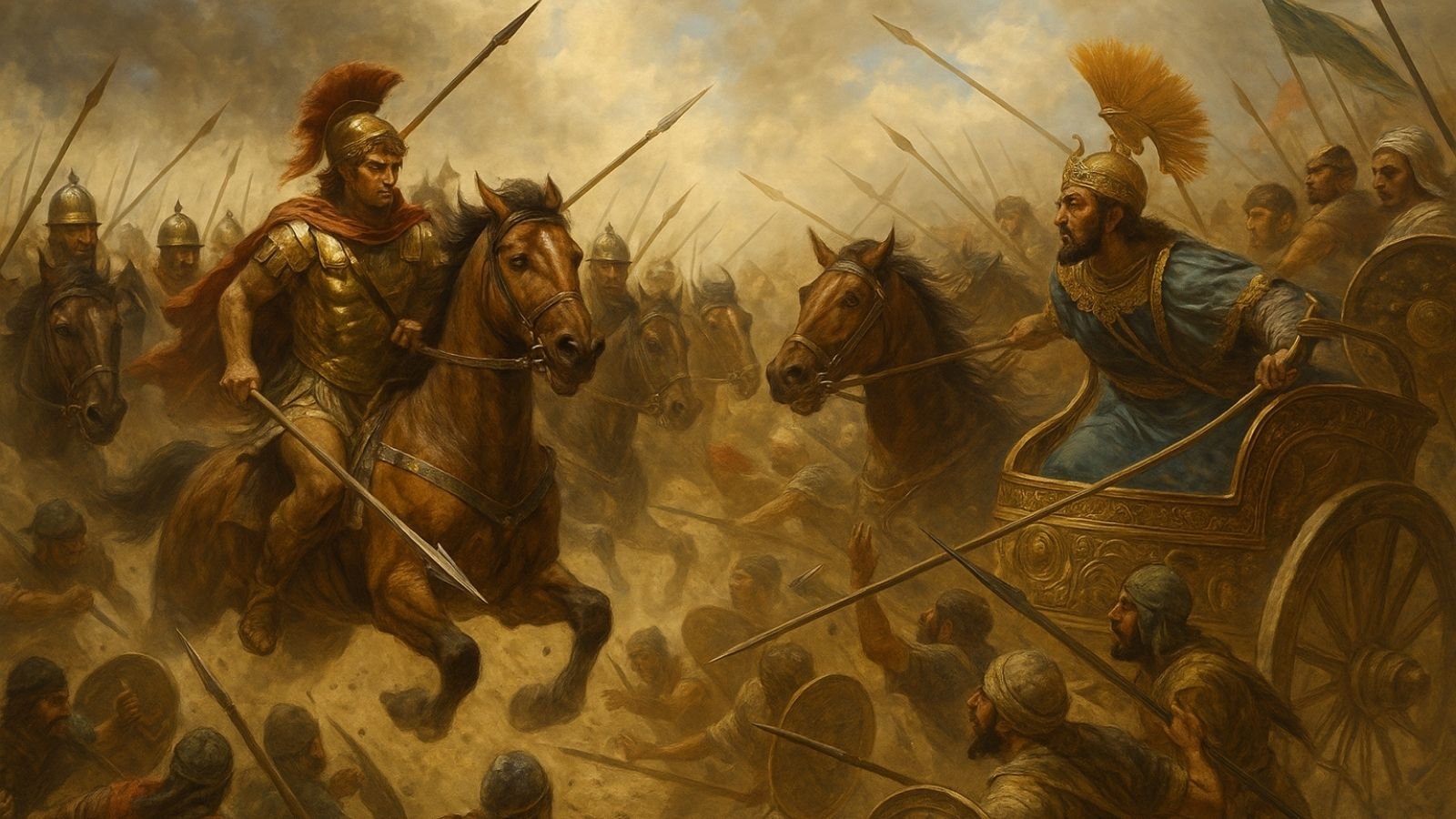The Battle of Gaugamela: How Alexander the Great Crushed Darius
The Battle of Gaugamela sits in history like one of those moments when the universe tilts, and suddenly the world’s balance changes forever. It’s October 1, 331 BCE, somewhere near a little village in what’s now northern Iraq, and a twenty-something Macedonian with a taste for glory decides that the world’s biggest empire isn’t big enough for the both of them. Spoiler: it ends badly for Persia.
Alexander of Macedon, already on a winning streak after Granicus in 334 BCE and Issus in 333 BCE, marched into Mesopotamia with a force that looked small next to Persia’s vast army. Ancient writers loved inflating Persian numbers—talk of a million men is pure theatre—but a reasonable estimate is about 100,000–120,000 Persians against Alexander’s 47,000 Macedonians. His force was lean: around 40,000 infantry and 7,000 cavalry. Darius, in contrast, had horses, infantry, scythed chariots with blades sprouting from their wheels, and even war elephants—his exotic trump card meant to terrify.
Darius picked the ground carefully. Flat, open, and levelled—ideal for his chariots and elephants. Alexander looked at this perfect Persian playground and thought: fine, we’ll use it against you. Instead of charging straight on, he angled his right wing diagonally forward, drawing Darius into overextending his line. This oblique advance was one of Alexander’s trademarks: a slanted attack that forced the Persians to spread thinner and thinner, like butter scraped across too much bread.
He also introduced innovation in how he used his infantry. Rather than a rigid phalanx wall, Alexander allowed controlled gaps to form between units. The Persians rushed into these spaces, believing they had broken through, only to find themselves trapped and attacked from the sides. It was a battlefield sleight of hand, turning supposed weakness into ambush.
The Persians had brought their terrifying scythed chariots, designed to slice through ranks like a farmer’s blade through stalks of wheat. Alexander’s solution was simple and brilliant: he trained his men to part and open lanes as the chariots charged. Skirmishers pelted the horses with javelins, while the chariots rolled uselessly through empty space. What had been intended as a weapon of terror became almost laughable in its futility.
And then there was the cavalry. Alexander’s Companion Cavalry didn’t charge as a flat block but in a wedge formation, a spearpoint of horse and armour designed to punch holes in enemy lines. At the critical moment, Alexander spotted the gap he had engineered in the Persian front. Leading the wedge himself, he drove straight for Darius. Imagine the scene: a young king in bronze armour, plunging into the heart of the enemy line, aiming directly at the Great King of Persia. Darius’s nerve failed—again, as it had at Issus. He turned and fled, abandoning the field. Once the king fled, the Persian army, however vast, became a leaderless mob.
The Persians still had numbers, but in ancient warfare, leadership is everything. Without Darius, their morale dissolved. Alexander, even in the heat of triumph, did not overextend. He broke off pursuit to rescue his left flank, which was under pressure from Persian cavalry. That balance—between reckless glory and calculated control—was part of his genius, and a subtle innovation in itself. Unlike many commanders who lost themselves in the thrill of victory, Alexander kept the whole battlefield in mind.
The consequences were seismic. The Achaemenid Empire, which had stood for over two centuries and stretched from the Aegean Sea to the Indus River, was effectively broken. Within months, Alexander entered Babylon, Susa, and Persepolis, the ceremonial capital of Persia. Darius fled east, hunted not just by Macedonians but also by disloyal satraps. In 330 BCE, betrayed by Bessus, he was killed on the run. Alexander, in a flourish of magnanimity and theatre, gave him a royal burial. The symbolism was clear: the old king was dead, the new king of kings stood triumphant.
The Battle of Gaugamela became more than just a military victory. It was a masterclass in innovation: how to use terrain, timing, and psychology to overcome overwhelming odds. The oblique formation, the flexible phalanx with calculated gaps, the wedge-shaped cavalry charge, and the neutralisation of scythed chariots all showed a new way of thinking about battle. It proved that disciplined, adaptable troops could dismantle a force twice their size. And beyond tactics, it marked the beginning of something new: the blending of Greek and Persian worlds into what historians call the Hellenistic age. Greek language, art, and philosophy spread eastward, while Persian traditions seeped west. The cultural fusion that followed reshaped centuries.
Ancient historians were captivated. Arrian wrote of Alexander as if he were a genius born for conquest. Plutarch painted him with mythic brushstrokes. Curtius Rufus lingered on the drama of Darius’s flight, a royal humiliation. Behind their storytelling, the reality remains that Alexander outthought and outmanoeuvred an empire.
And perhaps the most ironic part? Gaugamela itself was a modest village, chosen because it offered a flat surface for Persian chariots. It wasn’t famous before that day. But in a few hours, it became a byword for the fall of Persia and the rise of Macedon. One village, one morning, and the ancient world shifted on its axis.
So the next time someone insists history is a slow drift of trends, remind them of Gaugamela: the single morning when Alexander’s innovations toppled an empire, when Darius’s courage cracked, and when the world woke up to a new order led by a Macedonian barely out of his twenties.
